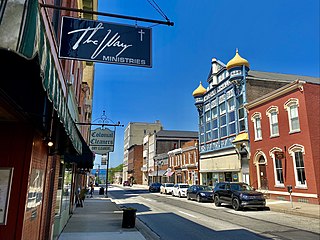
Latrobe is a city in Westmoreland County, Pennsylvania, United States. The population was 8,060 as of the 2020 census. A part of the Pittsburgh metropolitan area, it is located near Pennsylvania's scenic Chestnut Ridge. Latrobe was incorporated as a borough in 1854, and as a city in 1999. The current mayor is Eric J. Bartels.
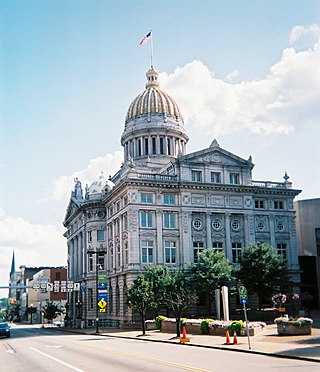
Westmoreland County is a county in the Commonwealth of Pennsylvania, United States, located in the Pittsburgh Metropolitan Statistical Area. As of the 2020 census, the population was 354,663. The county seat is Greensburg and the most populous community is Hempfield Township. It is named after Westmorland, a historic county of England.

Greensburg is a city in and the county seat of Westmoreland County, Pennsylvania, United States. The population was 14,976 at the 2020 census. Located 30 miles (48 km) southeast of Pittsburgh, Greensburg is a part of the Pittsburgh metropolitan area. The city lies within the Laurel Highlands and the ecoregion of the Western Allegheny Plateau. The city is named after Nathanael Greene, a major general of the Continental Army in the American Revolutionary War.

Henry Clay Frick was an American industrialist, financier, and art patron. He founded the H. C. Frick & Company coke manufacturing company, was chairman of the Carnegie Steel Company and played a major role in the formation of the giant U.S. Steel manufacturing concern. He had extensive real estate holdings in Pittsburgh and throughout the state of Pennsylvania. He later built the historic Neoclassical Frick Mansion, and upon his death donated his extensive collection of old master paintings and fine furniture to create the celebrated Frick Collection and art museum. However, as a founding member of the South Fork Fishing and Hunting Club, he was also in large part responsible for the alterations to the South Fork Dam that caused its failure, leading to the catastrophic Johnstown Flood. His vehement opposition to unions also caused violent conflict, most notably in the Homestead Strike.
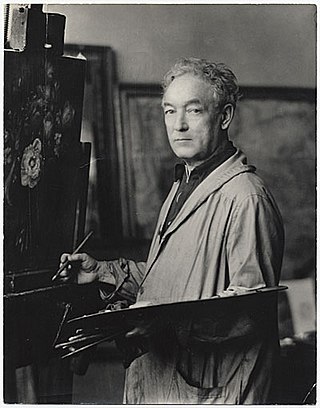
William James Glackens was an American realist painter and one of the founders of the Ashcan School, which rejected the formal boundaries of artistic beauty laid down by the conservative National Academy of Design. He is also known for his work in helping Albert C. Barnes to acquire the European paintings that form the nucleus of the famed Barnes Foundation in Philadelphia. His dark-hued, vibrantly painted street scenes and depictions of daily life in pre-WW I New York and Paris first established his reputation as a major artist. His later work was brighter in tone and showed the strong influence of Renoir. During much of his career as a painter, Glackens also worked as an illustrator for newspapers and magazines in Philadelphia and New York City.

Greater Pittsburgh is the metropolitan area surrounding the city of Pittsburgh in Western Pennsylvania, United States. The region includes Allegheny County, Pittsburgh's urban core county and economic hub, and seven adjacent Pennsylvania counties: Armstrong, Beaver, Butler, Fayette, Lawrence, Washington, and Westmoreland in Western Pennsylvania, which constitutes the Pittsburgh, PA Metropolitan Statistical Area MSA as defined by the U.S. Census Bureau.

The University of Pittsburgh at Greensburg is a state-related liberal arts college in Greensburg, Pennsylvania. It is a baccalaureate degree-granting regional campus of the University of Pittsburgh. Opened in 1963, Pitt-Greensburg was granted four-year degree-granting status in 1988. As of 2020, Pitt-Greensburg had 1,439 undergraduates and 96 faculty.

Greensburg station is an Amtrak railway station located approximately 30 miles (48 km) east of Pittsburgh at Harrison Avenue and Seton Hill Drive in Greensburg, Pennsylvania. The station is located just north of the city center. It is served only by Amtrak's Pennsylvanian, which operates once daily in each direction.

Cyrus E. Woods was an American attorney, diplomat and politician.
William Graham Connare was an American prelate of the Catholic Church. He served as Bishop of Greensburg from 1960 to 1987.

William Axton Stokes was an attorney born in Philadelphia, Pennsylvania, who lived for a time in Greensburg, Pennsylvania, where he served as legal counsel for the Pennsylvania Railroad Company. He went on to serve as an American Civil War major who contributed notes and references to an American edition of Mathew Hale's (1609–1676) Historia placitorum coronae published by R. H. Small of Philadelphia in 1847. Between January 1863 and August 1864, he owned The Republican, one of the first local newspapers in Greensburg, PA. He was elected as a member of the American Philosophical Society in 1872.

Arthur Watson Sparks was an American painter and art teacher.

The Greensburg Downtown Historic District of Greensburg, Pennsylvania, is bounded approximately by Tunnel Street, Main Street, Third Street, and Harrison Avenue. It consists of 62 buildings on 21.8 acres (8.8 ha), with the most notable buildings from the years 1872-1930. The district's oldest structure (1872) is the former Masonic Temple at 132 South Main Street. The Academy Hill Historic District is directly to the north of downtown Greensburg.
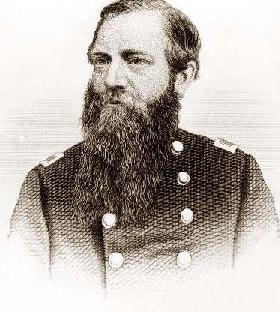
Richard Coulter, Sr. was an American Civil War Colonel and brevet brigadier general of volunteers in the Union Army, a businessman, and banker. During the Civil War he was colonel of the 11th Pennsylvania Infantry, often rising to brigade command upon the wounding of superior officers. In 1866, he was nominated and confirmed as a brevet major general of volunteers to rank from April 1, 1865.
Paul Amos Batholomew (1883–1973) was an architect in Greensburg, Pennsylvania. From the beginning of his practice, he received a variety of high-profile commissions for both residential and non-residential structures, mainly in Westmoreland County, Pennsylvania. His buildings typically had historicist facades, with neoclassical or Italianate ornamentation covering a modern framework. It was only in the 1950s, toward the end of his career, that he created buildings that were purely modern in design. During the Great Depression, a particularly trying time for architects, he received the commission to design Norvelt, which was a new town created as part of President Roosevelt's New Deal policies.
William Henry Gerdts Jr. was an American art historian and professor of Art History at the CUNY Graduate Center. Gerdts was the author of over twenty-five books on American art. An expert in American Impressionism, he was also well known for his work on nineteenth-century American still life painting.
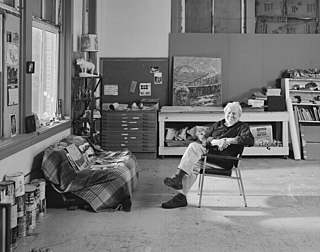
Robert L. Qualters, Jr. is an American painter, installation artist and printmaker based in Pittsburgh, Pennsylvania. His work encompasses traditional painting, as well as murals, and collaborations with other Pittsburgh-based artists across several disciplines. He is associated with the Bay Area Figurative Movement of Representational Painting.
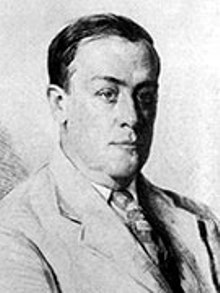
Rae Sloan Bredin was an American painter. He was a member of the New Hope, Pennsylvania school of impressionists. He is known for his peaceful spring and summer landscapes with relaxed groups of women and children.
Elizabeth Fisher Washington (1871–1953) was an American portrait and landscape painter.

William David Hanna, known as David Hanna, was an American artist who produced drawings, paintings, and sculpture in graphite, watercolor, egg tempera, drybrush, bronze, and marble. Hanna lived and worked in Pittsburgh, Pennsylvania, and Bristol, Maine. His art predominantly focused on the structures, furnishings, and people of those regions.


















